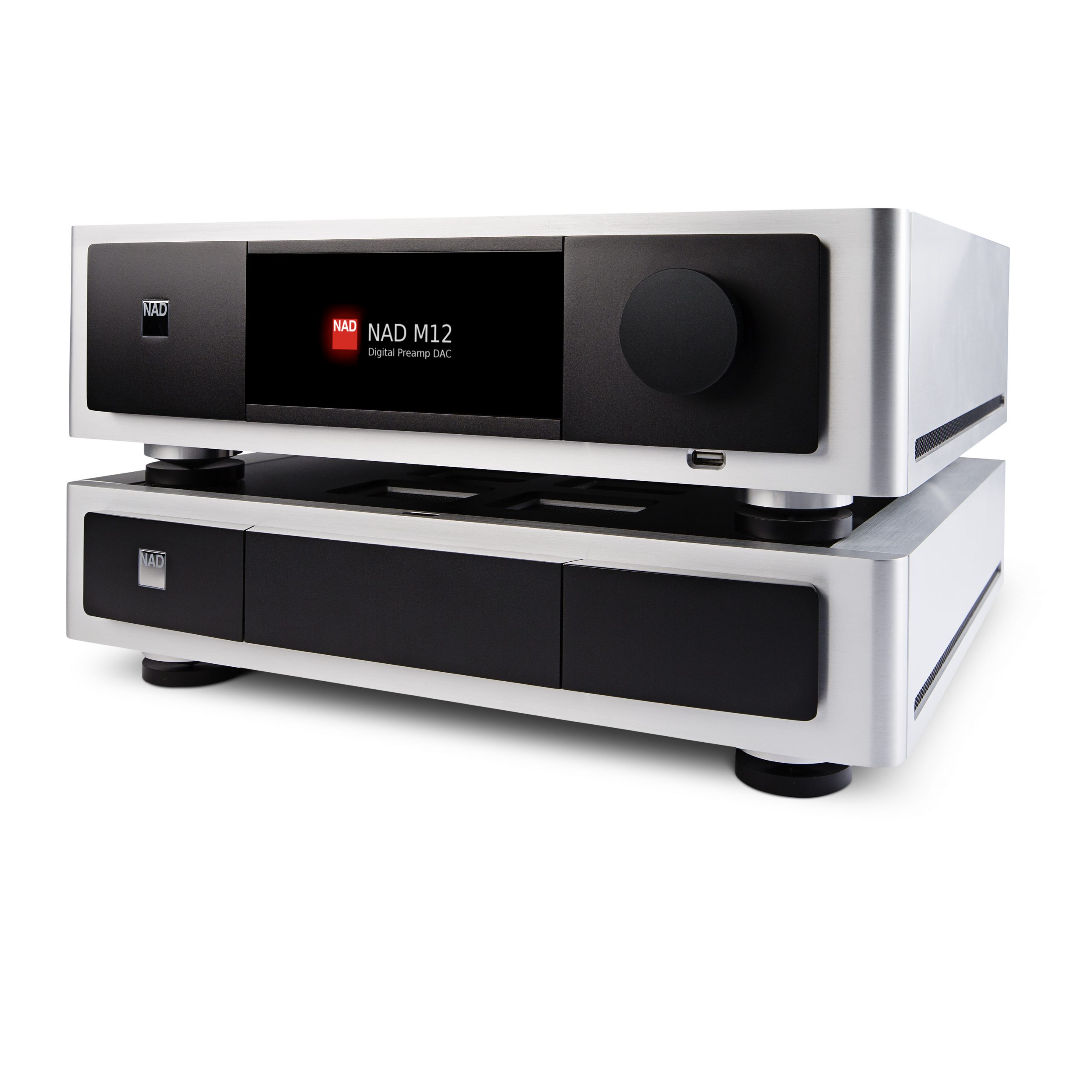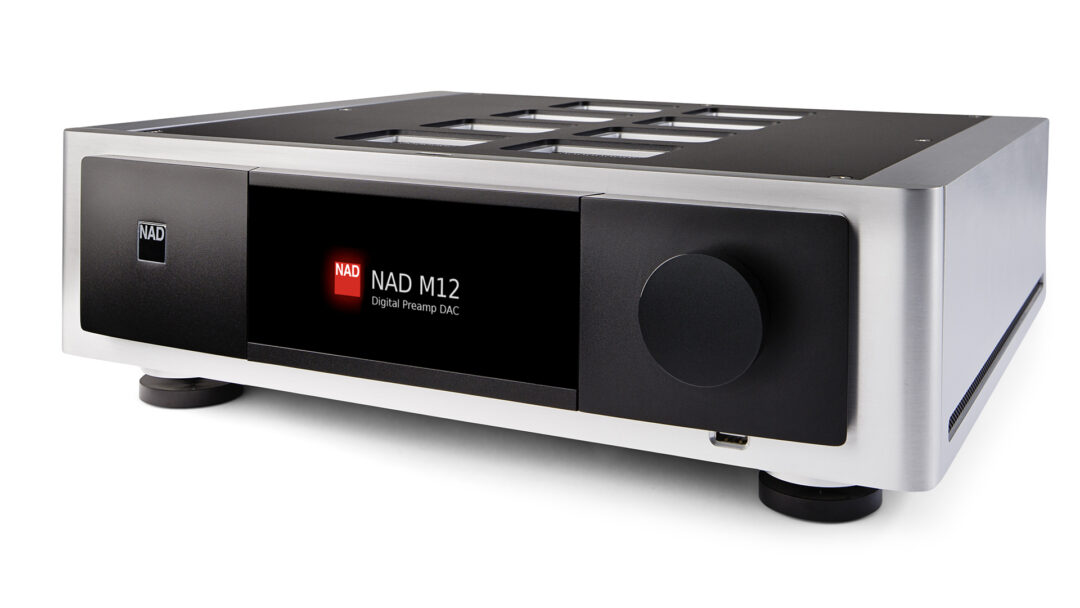What happens when engineers, who usually spend their time constructing good sound on a strict budget, get free hands and sit down to do the best they can without the cost hassle? Then you end up with something like NAD’s Masters series. We have recently tested several models from the series.
NAD M12 is the manufacturer’s offer for a high-end class preamplifier. Like the other devices in the series, it is a strictly designed aluminum block with rounded corners and a large, central touch screen. A large volume button is the only physically tangible control. It and a large solid remote control, also made of aluminum. With its 48 buttons, it can also control most devices in the Masters series.

Modular
The preamplifier is the central hub of the stereo system, where all signal sources are collected. And in such a luxurious product, of course, there is plenty of everything. The back plate is packed with inputs of all kinds. Some of them are mounted on interchangeable plug-in modules that can be removed with a pair of screws in the style of the cards in a desktop computer.

The system is called MDC (Modular Design Construction) and is used in a number of NAD’s top models, including the Masters series. The back plate on the M12 has free space for several extensions. Our test copy was delivered with a BluOS module for streaming and multi-room sound, and the analogue line and turntable inputs, which are part of the fixed equipment on the M12, also sit on an MDC module that can be purchased as an accessory for other models. .
If the amplifier is to be used in the stereo home theater, you can also buy an MDC module with four HDMI 2.0 inputs.
Everything is digital
NAD even calls the M12 a digital preamplifier, and it’s about more than just having digital inputs. All signal processing in M12 is digital – also the “analog”. After the line inputs and the RIAA amplifier, the signal is digitized, and then everything happens with 35 bit / 844 kHz resolution (!) Until the power amplifier outputs, which are analog. The very high resolution means that noise and distortion are lowered a further 66 dB compared to 24 bit signal processing. At least in theory. In practice, it is the analog part that sets the limit.
There is a full range of digital inputs: Eight in total and for all formats. Of course, the USB inputs work asynchronously so that any irregularities in the data flow from a computer do not affect the sound.
Multi-room
The NAD M12 can be expanded with Bluesound, which is NAD’s bid for multi-room sound in HD resolution. You can buy separate multi-room speakers, but also find the technology as an MDC expansion module. With the module mounted, BluOS appears as an additional input in the amplifier.
It also means that you can control it from the BluOS app on mobile and tablet, and it can be part of a multi-room system and stream wireless music to any room in the house. However, one does not necessarily need to procure a high-end system for every room.
Like the NAD M50 media server, the NAD M12 does not support DSD files. The much talked-about compressed HD audio format MQA is in turn supported, which makes it possible to enjoy high-resolution music from e.g. Tidal.
The sound of NAD M12
As a fully digital product, the M12 in particular comes into its own with digital signal sources. And it’s not so much a question of how it sounds, but how it does not sound. It appears to be unusually naked and clean, and is almost impossible to put a finger on. The sound in the speakers is determined to a greater extent by the other components in the system.
Do you want a balanced and neutrally controlled sound? Then the M12 must be combined with a good class D amplifier like the NAD M22 V2. Here there is subdued authority, crystal clear transparency and a deep and well-defined acoustic scene. There are plenty of details, but the sound does not become overanalytical for that reason. Just sober.
If you prefer a sound experience with more warmth and sweetness mixed in, the choice of power amplifier could fall on a single-ended tube amplifier or a class A amplifier. Put in front of our Nelson Pass Zen V2, there was detail, space and warmth in abundance on an otherwise rainy and gray February day.

All in all, the NAD M12 leaves significantly less mark on the reproduction than the connected power amplifier. It turns its job as a control center into something close to perfection and serves vinyl records, digital files and streaming with equal loyalty, but a truly distinctive look in vain. Which makes it an easy partner for most power amplifiers.
The experience of the “invisible” amplifier also includes an almost total freedom from distortion and noise – probably helped by the extremely high digital resolution. Until the initial stage, it is pure mathematics.
So is it the ideal preamplifier? Not necessarily, as music is all about emotions, and M12 is as matter-of-fact as a state-authorized public accountant. A preamplifier like the formidable McIntosh C2600 can touch the soul in a way that the M12 does not even try. But it does leave a deeper scar on the wallet. And you still have the opportunity to add personality to the other parts of the hi-fi chain.
Conclusion
NAD M12 is an excellent proof that NAD can make more than just sensible, gray boxes. It sounds great, and you have to go very high in price before it becomes the weak link in the hi-fi chain. At the same time, it offers all the inputs and formats you could want (phrased DSD).
Thanks to MDC, you are future-proof if the need or technology changes. If you can make do with slightly fewer inputs, however, you should look at the integrated M32, which is so close to the M12 in terms of sound that you almost need a target photo.


We think
Extensive selection of inputs, high sound quality and the possibility of expansion with new modules. MQA support with BluOS module. Costly. No DSD support. Streaming must be purchased as an option. Only one set of analog line inputs.
3499 €
Specifications
- Digital inputs: AES / EBU (XLR), 2 x coaxial, 2 x optical (TOSLINK), USB type B, USB type A (front and rear)
- Analog inputs: Line in (stereo RCA), balanced (stereo XLR), turntable (MM / MC) (stereo RCA)
- Outputs: Pre-out single-ended (stereo RCA) / balanced (stereo XLR), 2 x subwoofer (stereo RCA), digital out (optical / RCA)
- Resolution: 24 bit / 192 kHz out, 35 bit / 844 kHz internal
- Dimensions and weight: 43.5 x 13.3 x 38.3 cm / 8.1 kg

